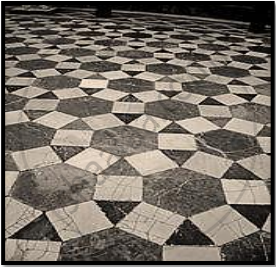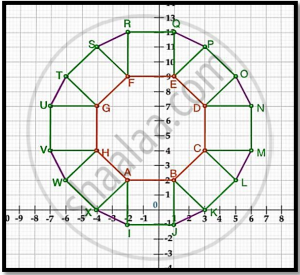Advertisements
Advertisements
Question
The points (3, -4) and (-6, 2) are the extremities of a diagonal of a parallelogram. If the third vertex is (-1, -3). Find the coordinates of the fourth vertex.
Solution
Let ABCD be a parallelogram in which the coordinates of the vertices are A (-2,-1); B (1, 0) and C (4, 3). We have to find the co-ordinates of the forth vertex.
Let the fourth vertex be `D(x,y)`
Since ABCD is a parallelogram, the diagonals bisect each other. Therefore the mid-point of the diagonals of the parallelogram will coincide.
Now to find the mid-point P(x,y) of two points `A(x_1, y_1)` and `B(x_2, y_2)` we use section formula as,
`P(x,y) = ((x_1+x_2)/2, (y_1+y_2)/2)`
The mid-point of the diagonals of the parallelogram will coincide.
So,
Co-ordinate of mid-point AC = Coordinate of mid-point of BD
Therefore,
`((x+1)/2, y/2) = ((4-2)/2, (3 -1)/2)`
`((x + 1)/2,y/2) = (1,1)`
Now equate the individual terms to get the unknown value. So,
x = 1
y = 2
So the forth vertex is D(1, 2)
APPEARS IN
RELATED QUESTIONS
Find the points of trisection of the line segment joining the points:
(2, -2) and (-7, 4).
Find the ratio in which the point (2, y) divides the line segment joining the points A (-2,2) and B (3, 7). Also, find the value of y.
The points A(2, 0), B(9, 1) C(11, 6) and D(4, 4) are the vertices of a quadrilateral ABCD. Determine whether ABCD is a rhombus or not.
Points A(-1, y) and B(5,7) lie on the circle with centre O(2, -3y).Find the value of y.
In what ratio does the point C (4,5) divides the join of A (2,3) and B (7,8) ?
Find the coordinates of the points of trisection of the line segment joining the points (3, –2) and (–3, –4) ?
Find the ratio in which the point (−3, k) divides the line-segment joining the points (−5, −4) and (−2, 3). Also find the value of k ?
The perpendicular distance of the P (4,3) from y-axis is
If (0, −3) and (0, 3) are the two vertices of an equilateral triangle, find the coordinates of its third vertex.
ABCD is a parallelogram with vertices \[A ( x_1 , y_1 ), B \left( x_2 , y_2 \right), C ( x_3 , y_3 )\] . Find the coordinates of the fourth vertex D in terms of \[x_1 , x_2 , x_3 , y_1 , y_2 \text{ and } y_3\]
If the point P (m, 3) lies on the line segment joining the points \[A\left( - \frac{2}{5}, 6 \right)\] and B (2, 8), find the value of m.
If the distance between points (x, 0) and (0, 3) is 5, what are the values of x?
Find the distance between the points \[\left( - \frac{8}{5}, 2 \right)\] and \[\left( \frac{2}{5}, 2 \right)\] .
If the points (k, 2k), (3k, 3k) and (3, 1) are collinear, then k
If points A (5, p) B (1, 5), C (2, 1) and D (6, 2) form a square ABCD, then p =
The coordinates of a point on x-axis which lies on the perpendicular bisector of the line segment joining the points (7, 6) and (−3, 4) are
f the coordinates of one end of a diameter of a circle are (2, 3) and the coordinates of its centre are (−2, 5), then the coordinates of the other end of the diameter are
Find the coordinates of point A, where AB is a diameter of the circle with centre (–2, 2) and B is the point with coordinates (3, 4).
The point R divides the line segment AB, where A(−4, 0) and B(0, 6) such that AR=34AB.">AR = `3/4`AB. Find the coordinates of R.
A tiling or tessellation of a flat surface is the covering of a plane using one or more geometric shapes, called tiles, with no overlaps and no gaps. Historically, tessellations were used in ancient Rome and in Islamic art. You may find tessellation patterns on floors, walls, paintings etc. Shown below is a tiled floor in the archaeological Museum of Seville, made using squares, triangles and hexagons.

A craftsman thought of making a floor pattern after being inspired by the above design. To ensure accuracy in his work, he made the pattern on the Cartesian plane. He used regular octagons, squares and triangles for his floor tessellation pattern

Use the above figure to answer the questions that follow:
- What is the length of the line segment joining points B and F?
- The centre ‘Z’ of the figure will be the point of intersection of the diagonals of quadrilateral WXOP. Then what are the coordinates of Z?
- What are the coordinates of the point on y-axis equidistant from A and G?
OR
What is the area of Trapezium AFGH?
